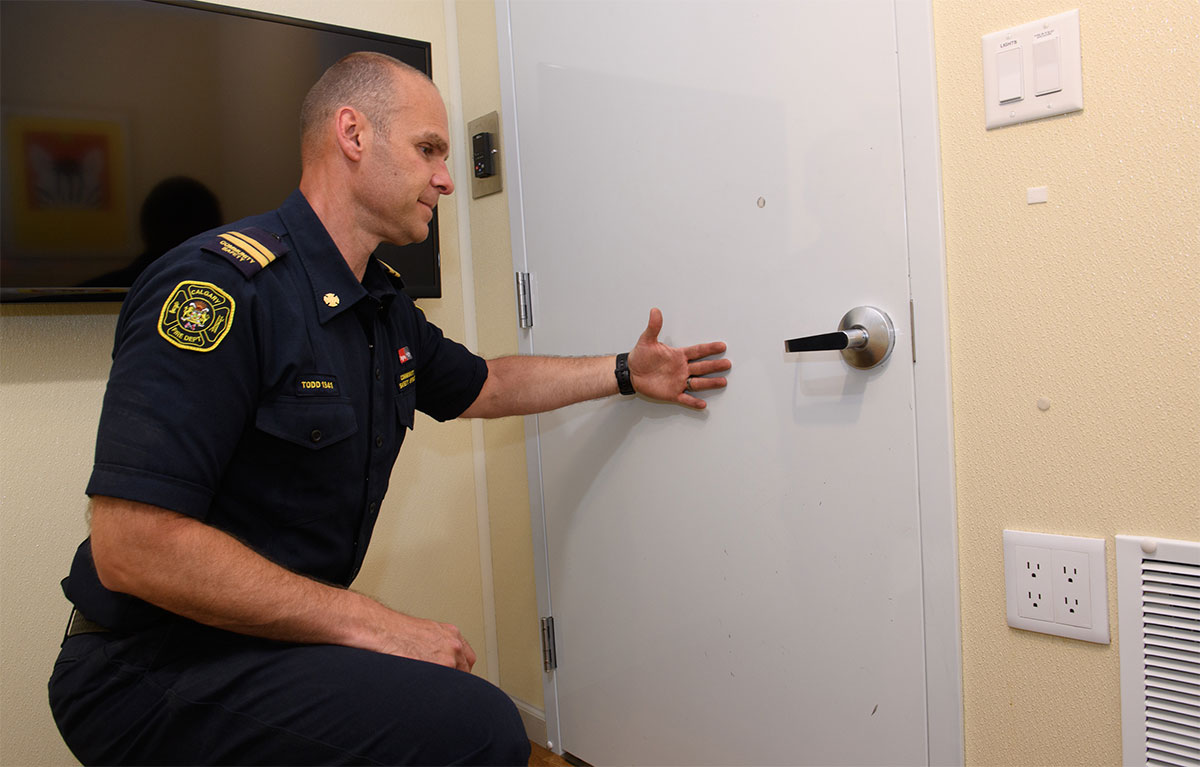High-rise building fire safety
Building safety
To save lives and minimize property damage, the fire safety features of your apartment or condominium building must be inspected and maintained.
Familiarize all occupants with the nearest crossover floor as many stairwells have tenant only access that require keys. However, there are crossover floors in high rise buildings that are unsecured so that you can get to another stairwell to evacuate.
Review your building’s bylaws regarding types of BBQ you can have.
Fire crews may use a stairwell to fight the fire, be familiar with all the stairwells in your building as you may be redirected to another stairwell to evacuate.
Alarms, emergency lighting, and sprinkler systems
Know who is responsible for maintaining these important safety systems in your building. Make sure that nothing blocks or otherwise interferes with such devices, and promptly report any sign of damage or malfunction to building management.
Listen carefully to any PA system announcements and know where the muster points are for your building.
Know where the smoke alarms and CO alarms are in your unit as well as centralized systems.
Fire exits
Never lock fire exits or block doorways, halls, or stairways. Fire doors not only provide a way out during a fire, they also slow the spread of fire and smoke. Never prop fire doors open.
Be prepared
You are far more likely to do the right thing in a real fire if you are prepared for an emergency.
- Learn your building's evacuation plans. Make sure everyone in your household knows where to go if the fire alarm sounds and practice your escape plan together.
- Read and learn evacuation plans in high traffic common areas, such as lobbies.
- Learn the sound of your building's fire alarm.
- Know at least two escape routes (including windows) from every room in your apartment or condominium.
- In the event of a fire, you may have to escape in the dark by feeling your way along the wall. Be prepared. Count the number of doors between your living unit and the two nearest building exits.
- Know where to find your building's fire alarms and learn how to use them.
- Post emergency fire department numbers near all telephones.
If a fire breaks out
Large numbers of people may evacuate at the same time in case of an emergency, some of them from upper floors.
- If you discover a fire, sound the alarm and call the fire department.
- If you can hear instructions over your building's public address system, listen carefully and do as you are told. You might be told to stay where you are.
- Leave the fire area quickly, closing all doors behind you to slow the spread of fire and smoke.
- Follow your building's evacuation plan unless doing so puts you in immediate danger. If you encounter smoke or flames, use an alternative escape route. Some evacuation plans may require you to go to a "safe area" inside the building and wait for the fire department to supervise evacuation.
- Test doors before you open them. While kneeling or crouching, reach up as high as you can and touch the door, the knob and the space between the door and its frame with the back of your hand. If the door is hot, use an alternative escape route.
- If the door feels cool, open it carefully and be ready to slam it shut if smoke or heat rush in.
- Never use an elevator during a fire. It may stop at a floor where the fire is burning or malfunction and trap you. Go directly to a stairwell that is free of smoke and flames.
- Once you are out, stay out, and stay out of the way of firefighters. Tell the fire department if you know of anyone trapped in the building. Do not go back inside for any reason, until the firefighters tell you it is safe to do so.

If you can't safely evacuate
- Stay as calm as possible.
- Never try to fight a fire, even a small one, until the alarm system has been activated, evacuation has begun, and the fire department has been called.
- When using an extinguisher, always have a clear escape route at your back. If the fire doesn't die down immediately or starts to spread, leave at once.
- If possible, go to a room with an outside window and a telephone.
- Close the door between you and the fire. Stuff the cracks around the door with towels, rags, or bedding and cover vents to keep the smoke out of the room.
- If there is a phone in the room where you are trapped, call the fire department and tell them exactly where you are. Do this even if you can see fire trucks on the street below.
- Wait at the window and signal for help with a flashlight, if you have one, or by waving a sheet or other light-colored cloth.
- If possible, open the window at the top and bottom, but do not break the window.
- Be ready to close the window quickly if smoke rushes in.
- Be patient. Rescuing all the occupants of a high-rise building can take time.
Other resources
-
Since 1996, Calgary firefighters have been visiting Calgary homes to share important home safety information and inspect, replace and install smoke alarms.
-
You may have as little as two minutes to escape from a house fire, knowing how to use those minutes can save lives.
-
Secondary suites in Calgary must comply with certain regulations in order to keep residents safe.
-
Properly installed and maintained fire safety equipment will help you escape your home during a fire.


